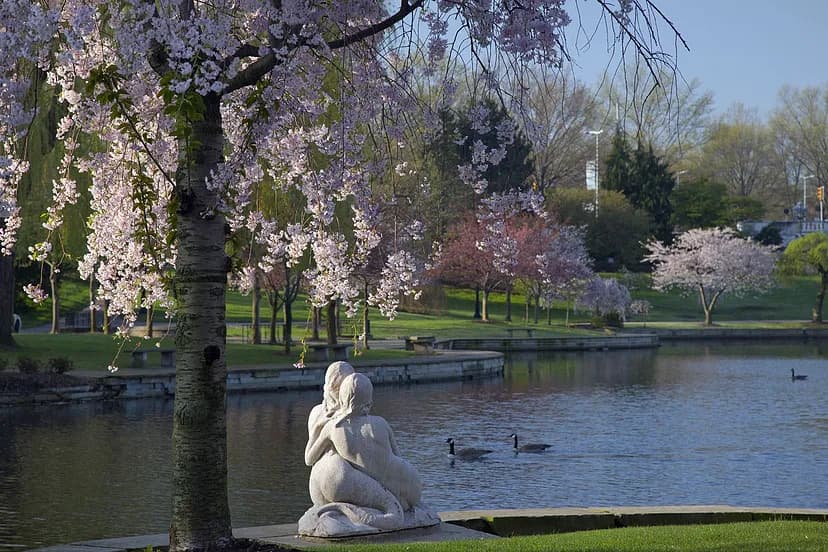Wade Lagoon and the City Beautiful Movement
- Blog Post
- Building and Grounds

Mermaids of the Earth. Photo courtesy of the Cleveland Museum of Art
Graduate students interning at the CMA through the Joint Program in Art History at the Cleveland Museum of Art and Case Western Reserve University (opens in a new tab) conducted historical research on the museum and its art for the full year of their internship. In these essays, the students share the findings and insights from their research. Courtney’s essay is the first in the series.
The land surrounding Wade Lagoon near the Cleveland Museum of Art was always intended to be a free and accessible public park; however, in the 1920s a nearby neighborhood was contractually segregated, thus impacting who had easy access to the park.

The series of events that led to the contract was sparked by W.E. MacEwan, who was selling his property through E.M. Bell, an employee at the Guarantee Title Building. A Black man attempted to purchase MacEwan’s house but was denied by Bell. MacEwan was never informed of this development, but in letters expressed his wishes that the property sell to whomever had the money and desire. When the Wade Park Committee (opens in a new tab) learned of MacEwan’s sentiments, the committee began to act against both MacEwan and any potential Black buyers by constructing a legal document that would not permit Black people to live in the area and took it upon themselves to segregate the community.
In the guise of a concern for property values, the committee constructed multiple contracts with homeowners on East Boulevard, Magnolia Drive, Hazel Drive, and East 115th Street to guarantee that no person who was not “of the Caucasian race” could live there.

Though there were a handful of dissenting voices, the committee succeeded in contractually segregating Magnolia Drive, Hazel Drive, Mistletoe Drive, and all properties on Wade Park Avenue between East 108th and East 115th Streets. The contract stipulated that racial segregation would last until at least 1946. At that time, the restrictions would be removed or reinstated.
The Wade Park Allotment Committee’s active participation in redlining likely resulted in greater contention between the White families and the immigrant and Black communities. The handful of dissenting voices were quickly drowned out by the overwhelming majority of those living in the area. The contract was typed up, signed, and went into effect.

Nearby, the firm of landscape architect Frederick Law Olmsted (opens in a new tab) had just finished the Fine Arts Garden. With its balanced and manicured landscape, the garden is an example of the City Beautiful Movement (opens in a new tab), a reform philosophy of North American architecture and urban planning that flourished during the 1890s and 1900s with the intent of introducing beautification and monumental grandeur in cities and sought to create good, moral citizens through their use of visually appealing public spaces. This was an unobtainable goal: lacking sanitation or other infrastructure to sustain the beautified spaces, the sought-after perfection faded as soon as it may have been achieved.
Based on what we have learned about nearby neighborhoods, we can assume that during the1920s, there were more White than Black visitors in the park surrounding the museum. This has changed over the course of a century, as the buildings in the Wade Park Allotment (opens in a new tab) were later acquired by Case Western Reserve University (opens in a new tab) (CWRU). East Boulevard is now home to multiple cultural institutions, including the Cleveland Museum of Art. Mistletoe Drive is now split between a community garden and buildings owned by CWRU. Today, students, visitors, and Clevelanders of all ages, races, and walks of life can be seen meandering around the lagoon.

Although the Centaur Fountain is gone, along with the boathouse and floating dock, replica water fountains stand where the originals stood. The area surrounding the lagoon, like the Court of Nature where you can find the Fountain of the Waters (opens in a new tab), retain their City Beautiful designs.
Today, the Cleveland Museum of Art tends to the upkeep of the Fine Arts Garden. The additional green spaces around the museum, like the Nord Family Greenway (opens in a new tab) and the Smith Family Gateway (opens in a new tab) provide direct walking paths that connect the CMA Case Western Reserve University, The Temple-Tifereth Israel (opens in a new tab), Cleveland Cultural Gardens (opens in a new tab), and many neighboring communities. With the expansion and maintenance of these areas, the museum aims to honor the original intent of making the area accessible, welcoming, and open for all to enjoy.


Courtney Toelle was a graduate intern in the CMA’s Academic Affairs department during the 2020–21 academic year. She graduated from Case Western Reserve University with an MA in art history and museum studies in spring 2021.